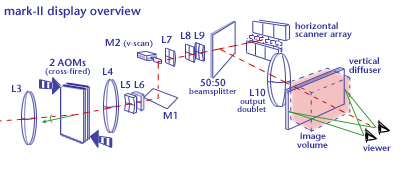| |
The
design strategy for the Mark-II holovideo display was to exploit
parallelism
wherever possible, both optically and electronically, such
that the approach would
be extensible to arbitrarily large image sized displays. To
acheive the goal of a
150x75x75mm image, two 18-channel Acousto-Optic Modulators
(AOM) were used,
with each channel of a single AOM modulating beams of red
light in parallel. Six tiled
horizontal mirrors scan across matched to the speed of the
signal in the AOM, such
that it appears the diffraction pattern in the AOM is stationary.
As the mirrors scan
from left to right, one AOM provides 18 lines of rastered
image. When the mirrors
return from right to left, the second crossfired AOM provides
the next 18 lines of
rastered image.
A
vertical scanner images each 18-line pass below the previous
one, with 8 horizontal scans in all, providing 18x8=144 vertical
scan lines.
The resulting image is horizontal parallax only (HPO), with
video resolution in the
vertical direction, and holographic resolution in the horizontal
direction. To match
the shear-mode active bandwidth of the tellurium dioxide crystal,
we need to produce
a signal with a ~50Mhz bandwidth. To provide the output sampling
at above the
Nyquist rate, we use a pixel clock of 110Mhz. Each horizontal
line of the display is
256-thousand pixels of holographic fringe pattern translating
to 36Mbytes of
information per frame, fed at a total data rate of 2Gpixels/sec
into the display
from the frame buffers.
To
drive this display, we needed an 18-channel frame buffer with
each channel
configured to provide 8 vertical lines of 256K pixels. While
no known off-the-shelf
frame buffer is capable of this, we were able to adapt the
Cheops Imaging
System to the task. Cheops is a data-flow architecture digital
video platform
developed at the MIT Media Laboratory. The Holovideo Cheops
system provides
six synchronized frame buffers to drive our 256Kx144 display
as well as a high
speed interface to host processors and a local data-flow processing
card for
decoding of encoded or compressed image formats.
SELECTED
REFERENCES:
The
design of the Mark-II Holovideo Display is detailed in the
following Doctoral Dissertation:
Pierre St.-Hilaire, Scalable
Optical Architectures for Electronic Holography, Ph. D.
Thesis, Program in Media Arts and Sciences, Massachusetts
Institute of Technology, September 1994.
A
more concise, although somewhat outdated description of the
display is available as:
Pierre St-Hilaire, Stephen A. Benton, Mark Lucente, John D.
Sutter, and Wendy J. Plesniak, Advances
in Holographic Video," in S.A. Benton, ed., SPIE
Proceedings Vol. #1914: Practical Holography VII: Imaging
and Materials, (SPIE, Bellingham, WA, February 1993), pp.
188-196.
An
up to date description is in the following publication:
P. St.-Hillaire, M. Lucente, J.D. Sutter, R. Pappu, C.J.Sparrell,
and S. Benton. "Scaling up the MIT holographic video
system" Proceedings of the Fifth International Symposium
on Display Holography (Lake Forest College, July 18-22, 1994),
SPIE, Bellingham, WA, 1995.
There is also a more comprehensive list of references on the
Mark-II display, and other projects at the Spatial Imaging
Group's publications page.
|
|


